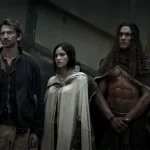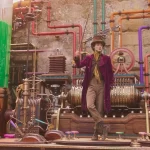Malick Then and Now, by Alexander Miller
Terrence Malick arrived during the height of the American New Wave in 1973 with his first feature film, Badlands. Due to his sporadic output, Mr. Malick isn’t frequently associated with the New Hollywood Movement. The sustained hush that permeates the homicidal trek of Kit and Holly coalesce with the anti-authoritarianism channeled by Malick’s (now emblematic) style fell in line with the counter-cultural atmosphere that permeated the American New Wave. But, Malick didn’t ride the crest of this movement but refined his craft and returned five years later with the visually sumptuous western fable Days of Heaven, with a somewhat “traditional” narrative but inscrutable and atmospheric in tone. Twenty years Malick returned with The Thin Red Line; a multidimensional mosaic of WWII, a terrifying and philosophical treatise on the nature of war. Come 2005 his film The New World was one of the first of his limited filmography to show cracks in his critically renowned career. In thirty years, Terrence Malick had made four films, keeping himself at such a remove from the public eye that he made Kubrick look like a socialite by comparison, and The New World marks a departure from his first half of his career. Like the projects preceding this film, Malick utilized the past to illustrate the mystifying nature of life and the through line for these pictures is Malick’s penchant for externalizing humankind’s incomprehensible relationship with our surroundings and the people who inhabit them.
The Tree of Life signaled Malick’s radical departure from structure and formula, using the platform of a man trying to reconcile the memories of his childhood, thus opening the door to meditate on earth and the evolution of human life. While that’s the consolidated synopsis of the film, and in the spirit of the films tone one has to sidestep characters and story to focus on its strength employing visual splendor and non-linear design. The five years between The New World and The Tree of Life seemed like a tiny gap regarding the director’s elusive creative style, so the immediacy of his follow up To the Wonder arriving just one year later was almost startling. Once again, he returns to similar, more humanistic material focusing on the devolving relationship of a young couple once they relocate to the states following their meeting in Paris. While The Tree of Life was an autobiographical portrait of the director’s childhood, To the Wonder is inspired by the Malick’s relationship with his first wife. In the summer of 2014 when trailers for Knight of Cups began circulating it looked like the director was venturing into new territory. The film is a remove from the more familial dramas beforehand, but it also follows the same MO as his previous work. Whether or not it’s intentional, Knight of Cups feels like the cap to an informal (and autobiographical) trilogy, following The Tree of Life and To the Wonder with a film whose protagonist is a wandering loner in the excess of Hollywood. It seems very self-reflective.
The creative growth of Terrence Malick is as fascinating as it is divisive. Some gravitate to his first three features and dismiss the later four or vice versa or embrace all of his work. But when you talk about his films, the follow up question is always “do you like his older movies or new ones?”
His latest film, Knight of Cups, falls into the formation of his work from The New World on; freewheeling, non-linear, full of philosophical whimsy, beautiful images, limited (spoken on screen) dialogue and thin characters. Partially self-indulgent, but territorially unfamiliar to his previous work Knight of Cups will please as many as it detracts. This is a recurring case with all of his films from 2005 on. Christian Bale is the wandering protagonist, a screenwriter who’s at odds with his father, brother, former wife, trying to understand the world around him. Character’s names at this point (after The Tree of Life) are at such a remove you might as well call them “the women, the man, the son, the other son, etc.”, the metaphysical distance services Malick’s intuitive style, but shows a redundancy in his later work. The advantage of digital cinematography can also account for enabling Malick’s freewheeling approach to movie making. Being less expensive than film, as well as being small and portable, it cuts down on crew costs. Chivo and Terry can shoot even more footage to whittle down into a movie after the fact. Working in a contemporary setting seems to be a fitting canvas for the director; instead of paying for costumed extras, props (tanks, planes, etc.) it’s a lot more cost effective if he wants to continue doing stream of consciousness character studies.
Admittedly, much of the cast and crew in his second career worked without scripts. The product feels like the direction of his movies is “show me what your character is doing and we’ll tell you what it is through editing and voiceover.” There’re layers of existential ponderings, and symbolism galore. But the residual feeling about Knight of Cups is similar to that of his last few movies- an enveloping and beautiful experience that’s visually rewarding if dissonant and all too familiar with the two films beforehand.
2013’s To the Wonder reads similarly to Malick’s other films from this period, emotional struggles externalized by externalized artistic prowess. After The Tree of Life, watching To the Wonder affirmed Malick’s stylistic and structural intentions. The Tree of Life is spilling with visual flare, and the characters seem more realized than in his following films; taking on the creation of earth and evolution doesn’t fully congeal with the rest of the movie. Most reviews of The Tree of Life commend its ambition, and style but simultaneously forgive the loose roaming narrative, and thinly drawn characters. How does a film like The Tree of Life begin and end? Well, it doesn’t and I think that’s the point. Malick’s brazen and intensely personal artistry is commendable but, at this point, Terrence Malick’s work becomes “Malicky,” a parody of authorship which is indicative of the contention that arose from audiences during this period, and is legitimized in some respects. It seems like Terrence Malick’s current resurgence to the fact that our modern sensibilities are more accepting of his lack of formalism, the artful inclinations are present throughout his filmography, and 2011 was his turning point.
It seems like the case for The New World is similar to that of The Thin Red Line. The mythic proportions are executed in a way that yields a transfixing and mesmerizing historical epic while simultaneously deflating the pomp and splendor that we commonly associate with war films and period dramas. These two titles also reflect a director whose creative instincts are growing. The maturation from Badlands to this stage is huge but the emblematic trademarks (voice-over, expressive editing, atmosphere, and mood) of an auteur are thoroughly visible.
Whether it’s the dissonant voiceover of Holly in Badlands or Linda in Days of Heaven, their naiveté evokes their inability to articulate the motivations of those around them. By the time we get to The Thin Red Line the number of narrators grows from one point of view to several if singular motivations were incomprehensible to the characters in Malick’s earlier work than the ambitions that fuel the machinations of war will be implausible, regardless of how many informed minds are speaking to us through the movies constructs. Malick’s first three movies are terrific, and the dividing opinions of The New World aside I think it’s one of his strongest films. The New World expands the transformative midsection of the director’s career, still working from a linear model with atmospheric accentuation as he would edge further away from formal structure into existential expression.
Days of Heaven feels like Malick’s most uniformed film, fully drawn characters paired with the decentered spectacle and revisionist western fable with a familiar love triangle scheme. In lesser hands this would have been a good movie, but the perfect storm of talent (Malick, Geere, Almendros, Wexler, Morricone, Shephard) made Days of Heaven a masterpiece. Badlands; one of the strongest debuts of any director embodies many familiarities, but the film exhibits a self-conscious buffer from convention.
Terrence Malick is an unrivaled artist. Despite some idiosyncrasies, his commitment to his artistry is commendable. It sounds like a cliché to call him an enigma but, for the most part, he is. Terrence Malick might have a tendency toward pretentious emotional essays but he’s one of the most distinctive talents working in film. Never has a director broken out as such a success, withdraw from Hollywood for decades and continue to veer away from commercially viable material and not only remain in the public conscience but continue to work with more volume. I like Terrence Malick; I think his earlier films are stronger but his later movies have their good points as well. I hope he makes more movies. If they have more focus, I’ll be happy. If not, I’ll still watch them.



































I don’t care for either Thin Red Line or The New World. Those would be fine enough movies without getting all “Malicky”. The Tree of Life, which would normally be a rather typical bit of autobiography, benefits from that more philosophical approach. Contrariwise, Badlands and Days of Heaven benefit from taking the perspective of a young person who isn’t necessarily thinking in such terms.